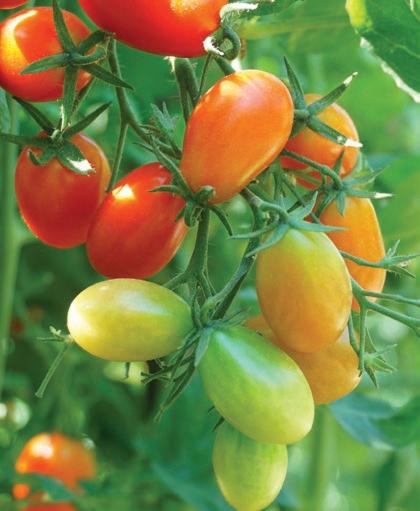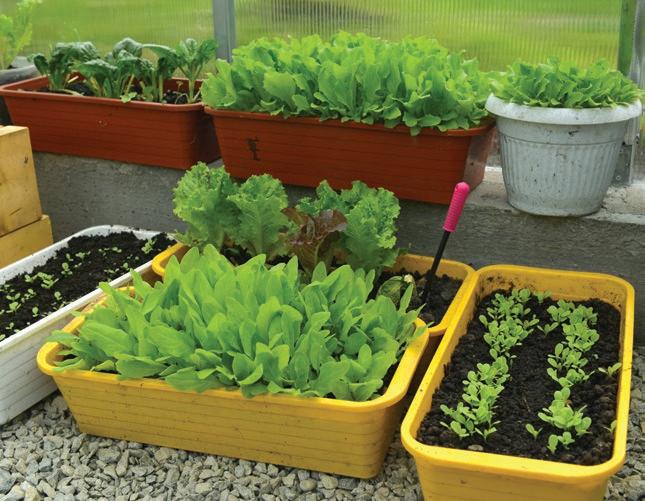
8 minute read
Veggies for small spaces
Tomato varieties suitable for hanging baskets; Sweet Bite, Yellow Pear, Yellow Cherry, Cherry Roma, Cherry Truss, Grape.



Growing tomatoes in pots and even hanging baskets is a great way to control their sunlight and position requirements, while adding a degree of functionality to gardens and outdoor spaces restricted in size.
Tomatoes need a sunny site and good drainage. As their roots are restricted in their growing space, plant in soil enriched with plenty of nutrients to maximise growth. For potted tomatoes and tomatoes in hanging baskets, use Searles Herb & Vegetable Specialty Mix to pot up. This mix, boosted with instant and controlled release fertilisers, will feed plants for up to 9 months, and importantly contains re-wetting granules to reduce the risk of soil dry out, which many pot plants are susceptible to.
Use smaller varieties of tomatoes that will grow more compact and don’t require as much nutrient and water. Tomato varieties named ‘Bush tomatoes’ and ‘dwarf tomatoes’ are ideal varieties to plant. These are readily available and require less space to grow and fruit.
To plant in hanging baskets, use a basket no less than 40-45cm in diametre. The smaller the basket the quicker the soil drys out and the nutrients are used. Tomatoes planted in baskets require more attention and regular watering, but when you meet their requirements, are a worth while feature plant, worthy of garden club talk.
/tomatoes in pots
For tomatoes in pots, again use larger pots rather than smaller ones. Plastic pots are fi ne to use, but can easily capture alot of heat during the hotter summer months. Monitor the soil temperate and move pots to a shadier place until the hot weather has past. Self-watering pots are a great way to regularly water plants when you forget. If using terracotta pots, seal the inside of the pot with terracotta pot sealant to reduce the loss of water through the pot walls.
Tomatoes are heavy feeders, though using the right fertiliser regularly will promote better health, pest resistance of the plant and increase fruit yields. For tasty, long-lasting fruit and resistance to pests and disease, apply SeaMax Fish & Kelp (for a liquid organic option) or Searles Flourish Vege & Tomato Fertiliser fortnightly.
A regular watering regime tailored to your plant variety and pot/basket size is paramount. The smaller the pot/basket the quicker the soil will dry out. Hanging baskets are more exposed to air fl ow, drying out the mix quicker.
Beans are an easy-to-grow, productive and nutritious warmseason crop. Beans are available either as ‘climbers’ or ‘bush beans’. Climbing beans grow vertically and can produce large volumes of beans in relatively little garden space. They can be ideal for sunny courtyards and smaller gardens. Bush beans are ideal for pots and even vertical gardens.
Beans can be easily grown from either seed or seedlings and handle transplanting well. In cool or mountain areas, make sure the last frost has passed before planting. Space plants as recommended on the seed packet or punnet — avoid planting them too closely as overcrowding can encourage fungal diseases. For climbing beans, support their growth by installing a trellis before planting.
Use a premium potting mix with excellent water holding features and long term fertiliser. Searles Herb & Vegetable Specialty Mix is ideal for pot planting.
Keep beans moist, but not wet while they are growing and water the roots of the plant, not the foliage or flowers. A dripper system and a layer of mulch can be ideal. Alternatively, dig a trench between rows and water it deeply once a week.

Beans are heavy croppers and harvest can begin when they are very small. The more beans you pick, the more they will produce and healthy plants can keep cropping for months.
Liquid feed with an organic fertiliser SeaMax Fish & Kelp Organic Fertiliser to encourage better flowering and beans.

A sudden bout of wet weather after a dry period can cause ripening tomatoes to split. This can also be caused by irregular watering.
Keep moisture levels consistent by watering tomatoes regularly and keeping them well mulched.
Water tomato plants on the roots — not the foliage. This will reduce the risk of fungal infections and will also limit water loss through evaporation.
Many tomato diseases are spread by sap-sucking insects, so controlling them will reduce the likelihood of a disease outbreak.

Most common pests can be kept at bay with an all-purpose organic spray such as Ecofend Vegetable &
Garden. Try organic solutions before looking to use chemical treatment options. Fruit can be covered with paper bags just before it starts to colour up. Fly paper attached to stakes and fruit-fly baits can also reduce pest numbers.
grape tomatoes
Tomato ‘Red Tumbler’
- Suitable for a hanging baskets. Grows 0.4m H Tomato ‘Tumbler’
- Suitable for a hanging basket. Grows 0.4m H Tomato ‘First Prize’/’Patio Prize’
- Suitable for a hanging baskets & pots. Grows 0.5m H Tomato ‘Tommy toe’
- Grows 1.5m in height. Must be staked. Tomato ‘Sweet Bite’
Maximise your outdoor living space by creating a vertical herb garden. Choose a structure style that will support the vertical area and your culinary needs. There are a myriad of DYI and ready-to-go vertical wall kits available to erect within minutes, or use your creativity to customise something unique to suit your style of space.
Choose herbs and edible flowers that are suited to the amount of light the area receives. Most herbs and flowers require a good amount of sunlight per day. Plant parsley, thyme, mint, lettuce, dill, rosemary and for a touch of colour tuck in a few edible pansies, nasturtiums, salvias and marigolds. Try to avoid herbs that grow too tall and go to seed quickly.
For a quicker final result, plant advanced plants or seedlings. Choose plants that don’t outgrow the space provided or hang intrusively over walkways.
Use premium quality potting mix which allows free drainage and can hold in the moisture in at the same time. Premium potting mixes like Searles Platinum Potting Mix contain excellent water holding capabilities and controlled release fertilisers to feed plants for up to 18 months for stronger and thicker growth.
To maximise watering ingenuity, create a vertical wall system which waters from the top and the excess water runs down to the lower tiers. Some premade vertical wall kits cater for dripper systems. Keep in mind some herbs require their soil to be moist while others like it a little drier. Group plants together which have the same water requirements. For example, Mediterranean herbs such as thyme and rosemary need well-drained, drier soil and are best positioned together and at the top of the wall. Herbs which require regularly moist soil, such as, mint, basil and lemongrass, are best planted at the lower levels of a vertical garden.
Photo Credit: GAP Photos/Anna Omiotek-Tott - Designer: Andy Bending

Coriander, parsley, basil, mint, marjoram, thyme, rosemary, nasturtium, salvia, lemongrass, chives, chilli, tarragon, oregano, Vietnamese mint, fennel, chervil, dill, lovage, watercress, wild rocket, stevia (sugar bush) and ginger. Pansies, violets, snapdragons, nasturtiums, salvias, marigolds, daisies (Bellis perennis), chamomile, dianthus, etc.
Don’t forget many herbs have edible flowers, thyme, dill, borage, etc.
Lettuce trays.

Mint, oregano & lettuce love container life.

Gardeners with limited growing space can easily raise mesclun mix, lettuce, herbs, sprouts, and any other leafy greens, in seedling trays, planting troughs or recycled Styrofoam boxes. Searles Herb & Vegetable Specialty Mix will be ideal for sowing your seed or planting seedlings, as it contains both readily-available and controlled release fertilisers for up to 9 months of nutrition. It also holds adequate water for plump, juicy leaf growth as it contains peat moss, Penetraide rewetting granules and water crystals. Ensure your planter is in a sunny, protected position for maximum growth.
It’s vital that adequate nutrition is available for rapid growth of your leafy greens. Slow growth and hungry plants will produce bitter-tasting greens all round, something to be avoided at all costs.
Once seedlings emerge, fertilise immediately with Searles Flourish Vegetable and Tomato Soluble Plant Food and then every 10-14 days afterwards. For increased resistance to pest and disease attack, it’s also recommended to apply Searles Seamax Organic Fish & Kelp every fortnight.
Smaller containers need more watering than larger ones. Water leafy greens daily to keep the soil moist and crop tastier.
Harvest greens as often as you can. The younger leaves have the most fl avour.

Zucchini are a warm season crop. They can be grown in either full sun during spring and autumn, or semi-shade in the heat of the summer. Compact varieties of Zucchini can be grown in pots. As a general rule, plant one plant per pot. Good drainage and soil containing plenty of nutrients is important to aid quick growth, and free drainage also helps to prevent fungal infections.
Soil should be kept very moist up until the time that the fruits begin to mature, after which watering should taper off so the roots remain slightly damp. When watering, it is important to use a dripper system, so the foliage, stems and fruit are kept dry. Mulch after planting to protect the shallow roots from drying out and to prevent the above-ground parts of the plant from coming into contact with the soil.










